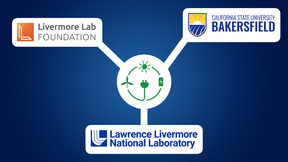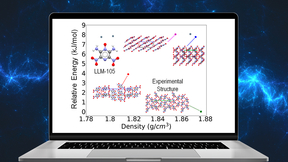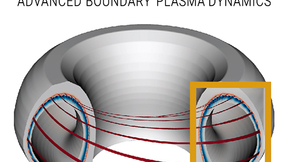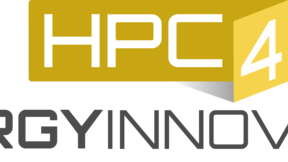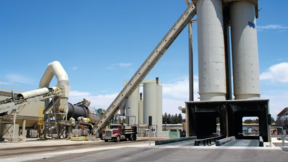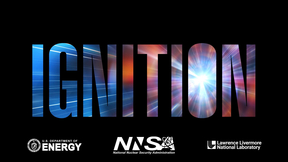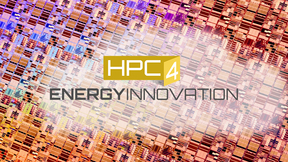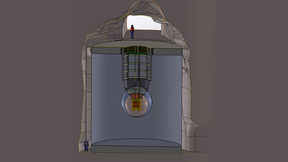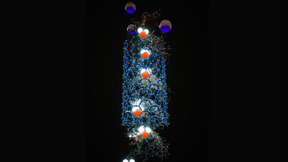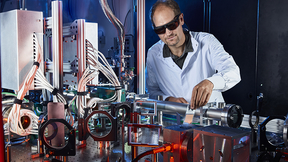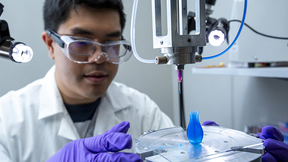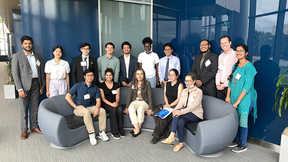Back
Energy
LLNL, CSU Bakersfield and Livermore Lab Foundation sign MOU to advance clean energy
Lawrence Livermore National Laboratory (LLNL), California State University, Bakersfield (CSUB) and the Livermore Lab Foundation (LLF) have signed an agreement to collaborate on advanced and clean-energy technologies, research opportunities and community partnerships that have the potential to shape the future of energy in the state and bring high-quality jobs to the region…
New Lab projects to promote STEM diversity, accelerate battery research
Lawrence Livermore National Laboratory (LLNL) will partner with outside institutions to improve diversity in the STEM workforce and provide training to underrepresented students and researchers under a pair of projects recently funded by the Department of Energy. With support from DOE’s Funding for Accelerated, Inclusive Research (FAIR) initiative, LLNL will partner with…
LLNL receives four 2023 TCF grants
Lawrence Livermore National Laboratory (LLNL) researchers have racked up another top-notch year for securing grants through the Department of Energy’s (DOE) Technology Commercialization Fund (TCF) program. Matt Garrett, who was named earlier this year to lead the Lab’s Innovation and Partnerships Office (IPO), noted that the Lab’s engagements with industry are crucial for…
New research shows successful ab initio crystal structure prediction of energetic materials
New research by Lawrence Livermore National Laboratory researchers and collaborators from Carnegie Mellon University (CMU) demonstrates that crystal structure prediction is a useful tool for studying the various ways the molecules can pack together, also known as ubiquitous polymorphism, in energetic materials. The research also shows promise of becoming an integral part…
LLNL-led project to advance understanding of plasma dynamics for future fusion power plants
A Lawrence Livermore National Laboratory-led project aimed at using computing tools to improve understanding of fusion plasma dynamics was among 12 projects recently awarded funding by the Department of Energy (DOE) to accelerate fusion power plant development. The four-year, multi-institutional Advanced Boundary Plasma Dynamics (ABOUND) project will receive $9.25 million…
LLNL develops portable Thomson scattering diagnostic to support ARPA-E’s fusion energy ventures
Scientists at Lawrence Livermore National Laboratory (LLNL) collaborated with University of California San Diego (UCSD) to design, assemble, and field a portable optical Thomson scattering diagnostic system for the Advanced Research Projects Agency-Energy (ARPA-E) — a Department of Energy agency which supports private companies that are developing new ways to generate,…
LLNL team reaches milestone in power grid optimization on world’s first exascale supercomputer
Ensuring the nation’s electrical power grid can function with limited disruptions in the event of a natural disaster, catastrophic weather or a manmade attack is a key national security challenge. Compounding the challenge of grid management is the increasing amount of renewable energy sources such as solar and wind that are continually added to the grid, and the fact that…
Department of Energy announces opportunity for industry to connect with national laboratories to develop energy efficiency technologies
The Department of Energy (DOE) today announced a new solicitation to connect industry partners with the high-performance computing (HPC) resources and expertise at DOE’s national laboratories to improve material performance and advance manufacturing processes for an equitable clean-energy future. Through the High-Performance Computing for Energy Innovation (HPC4EI)…
DOE announces additional funding for HPC4Energy Innovation projects
The Department of Energy (DOE) today announced $3.9 million for 13 public-private partnerships that will apply high performance computing (HPC) to manufacturing processes and advanced materials, including a Lawrence Livermore National Laboratory (LLNL) collaboration to decarbonize asphalt production. The awards, representing DOE’s fall 2022 round of funding for the High…
Lawrence Livermore National Laboratory achieves fusion ignition
The U.S. Department of Energy (DOE) and DOE’s National Nuclear Security Administration (NNSA) today (Dec. 13) announced the achievement of fusion ignition at Lawrence Livermore National Laboratory (LLNL) — a major scientific breakthrough decades in the making that will pave the way for advancements in national defense and the future of clean power. On Dec. 5, a team at…
HPC4EnergyInnovation initiative opens fall 2022 solicitation
The High-Performance Computing for Energy Innovation (HPC4EI) initiative has opened its fall 2022 solicitation cycle to industry partners interested in collaborating with the Department of Energy (DOE) to address key energy and decarbonization-related challenges. The sponsors of this solicitation are the HPC4Manufacturing (HPC4Mfg) and HPC4Materials (HPC4Mtls) programs,…
Lab-led nEXO project receives Inflation Reduction Act funding
Lawrence Livermore National Laboratory (LLNL) has received $2.35 million from the Inflation Reduction Act, which aims to support domestic energy production and promote clean energy and to provide the Department of Energy (DOE) national laboratories with resources to keep the U.S. at the forefront of scientific discovery. The funding has been allocated for the Lab-led nEXO…
LLNL to participate in three energy-focused projects
Transforming the way energy is collected, stored and used has become a defining challenge of the 21st century. To address this task, the Department of Energy’s (DOE) Office of Basic Energy Sciences (BES) established the Energy Frontier Research Center (EFRC) program. This year, Lawrence Livermore National Laboratory and collaborators were awarded three projects. The first…
'Twisted' laser light experiments offer new insights into plasma physics
Electromagnetic vortices occur naturally throughout the universe and have recently been observed in association with black holes. Over the last decade, scientists have sought methods to investigate how extremely strong electromagnetic vortices interact with matter, specifically plasma, in a laboratory setting. Plasma, known as the “fourth state of matter,” makes up nearly…
New method sheds light on solid-state battery fabrication
Safe, long-cycle-life batteries with high energy density are greatly needed with the rapid growth of electric devices and vehicles and grid energy storage demands. Lawrence Livermore National Laboratory (LLNL) scientists have devised a method for the fabrication of all-solid-state lithium metal batteries, which have been recognized as the future choice of safe and high…
Livermore researchers collect three awards among the top 100 industrial inventions
Lawrence Livermore National Laboratory (LLNL) scientists and engineers have garnered three awards among the top 100 industrial inventions worldwide. The trade journal R&D World Magazine recently announced the winners of the awards, often called the “Oscars of invention,” recognizing new commercial products, technologies and materials that are available for sale or…
LLNL and Case Western Reserve University to continue collaboration
The leaders of Case Western Reserve University and Lawrence Livermore National Laboratory (LLNL) signed a memorandum of understanding (MOU) to accelerate their efforts in shared areas of excellence. After three years of growing institutional collaboration in such areas as energy, materials science and polymer processing, Case Western Reserve President Eric W. Kaler…
An open-source, data-science toolkit for energy GridDS
As of 2020, 102.9 million smart meters — devices that record and communicate electric consumption, voltage and current to consumers and grid operators — have been installed in the United States. As the number of smart meters and the demand for energy is expected to increase by 50 percent by 2050, so will the amount of data those smart meters produce. While energy standards…
Research finds mechanically driven chemistry accelerates reactions in explosives
Scientists at the Lawrence Livermore National Laboratory (LLNL) Energetic Materials Center and Purdue University Materials Engineering Department used simulations performed on the LLNL supercomputer Quartz to uncover a general mechanism that accelerates chemistry in detonating explosives critical to managing the nation’s nuclear stockpile. Their research is featured in the…
DOE announces new funding for High Performance Computing for Energy Innovation projects
The U.S. Department of Energy (DOE) today announced the latest funding round for the High Performance Computing for Energy Innovation (HPC4EI) initiative, awarding $3 million for 10 projects applying DOE supercomputing to advance clean energy technologies and improve manufacturing efficiency. HPC4EI is the umbrella initiative for the HPC4Manufacturing (HPC4Mfg) and…


